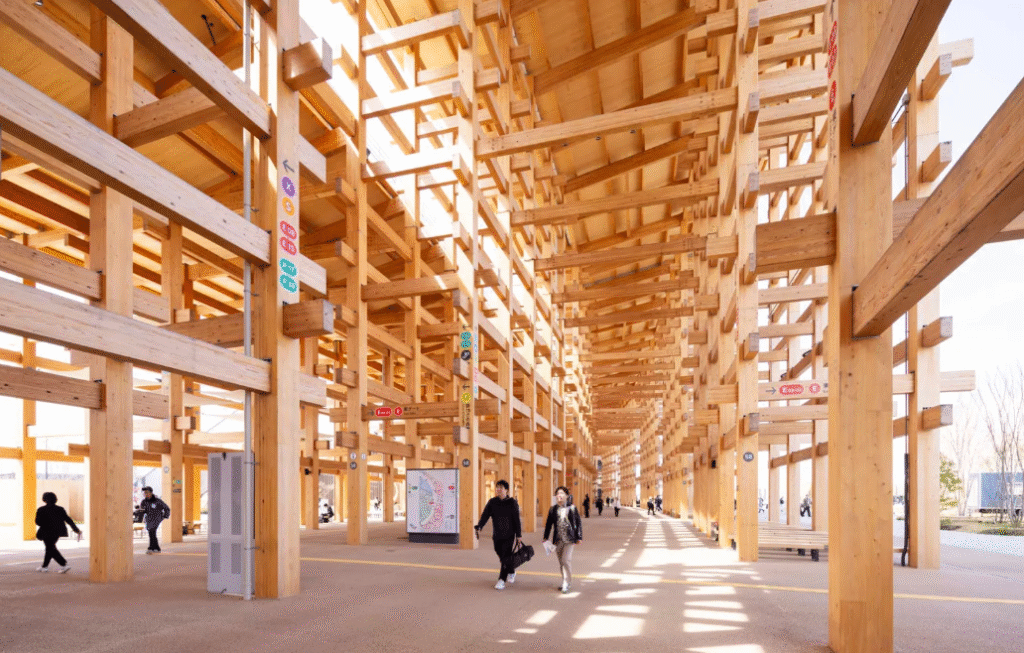Share This Article
A Pavilion Playground with Purpose
When you think of a world expo, you might picture cutting-edge tech, soaring architecture, and a rush of international innovation—and you’d be right. But Osaka Expo 2025 is preparing to offer something even more revolutionary: a vision of the future that is rooted in sustainability, humility, and circular design.
Set to open in April 2025, Expo 2025 will transform Yumeshima, a reclaimed island in Osaka Bay, into a vibrant global village. But this is not your typical steel-and-glass utopia. The centrepiece of this world fair is a sprawling circular wooden roof, built from recyclable Japanese timber, covering 60,000 square meters. It’s not just a feat of design—it’s a manifesto in architectural form.
What Makes Osaka Expo 2025 Different?
At its core, the Expo is embracing the principles of reuse, reduce, recycle with real architectural conviction. Designed by renowned architect Sou Fujimoto, the ring-shaped timber roof will connect multiple pavilions from over 150 countries and organizations. The most striking part? It’s not a permanent structure.
Everything—yes, everything—is designed to be dismantled, reused, or repurposed after the Expo ends. Unlike many past expos that leave behind ghost sites or white elephants, Osaka’s master plan prioritizes circularity and long-term value.
Circular Design in Action
The timber canopy isn’t just symbolic—it represents a massive carbon-conscious effort. Japan, a country that has long revered timber construction from its temples to townhouses, is putting its architectural traditions to the test in a new, modern context.
The use of locally sourced wood, modular structures, and prefabricated systems makes the Expo a living example of sustainable architecture. Each nation’s pavilion has been encouraged to follow suit: use low-impact materials, aim for energy neutrality, and design with the future in mind.

Designed by Sou Fujimoto, The Grand Ring spans 2 kilometers in circumference and rises 20 meters high, making it the largest wooden architectural structure in the world.

View from the top of The Grand Ring at the Osaka Expo 2025
Themes That Matter
The Expo’s overarching theme—“Designing Future Society for Our Lives”—explores the intersection of life sciences, AI, ecology, and cultural exchange. But the spatial language of the Expo itself echoes this idea. It’s not about showcasing flashy statements. It’s about quiet innovation, thoughtful design, and interconnection.
Visitors will encounter exhibits focused on human well-being, planet-positive technology, and inclusive urban futures. Rather than a one-way spectacle, the layout promotes flow, interaction, and dialogue. You’ll walk, rest, and reconnect—all beneath a timber sky.
Why This Matters for the World
Osaka Expo 2025 arrives at a time when the world is redefining progress. Can we imagine an architecture of restraint, rather than excess? Can pavilions become platforms for collaboration rather than nationalist display?
In a world reeling from climate change and resource scarcity, Japan’s approach offers hope. It shows us that a major global event can be built on sustainability, respect for natural materials, and circular economy principles—without sacrificing innovation or aesthetics.
What Architects and Designers Can Learn
For architects, designers, and urbanists, Expo 2025 is a masterclass in regenerative thinking. It’s a reminder that temporary structures can leave lasting impact, and that the best design doesn’t just solve problems—it anticipates them. Whether you’re planning an eco-resort, a public school, or a neighborhood plaza, there’s something to take away from how Osaka is doing it—lightly, beautifully, and with purpose.

Portugal Pavilion at Expo 2025 Osaka highlighting sustainability and ocean innovation through immersive, design-forward exhibits.
Looking Ahead
Osaka Expo 2025 isn’t just about imagining the future—it’s about building it, piece by recyclable piece. For Japan, it’s a chance to lead by example. For the rest of us, it’s a blueprint worth watching.

Toyo Ito’s Shining Hat pavilion at Expo 2025 Osaka, a striking dome-shaped hall designed to host up to 2,000 visitors in a light-filled, futuristic space.
Source: Monocle
